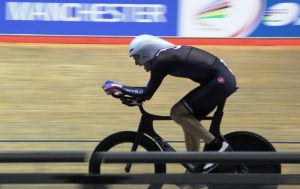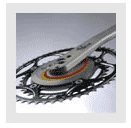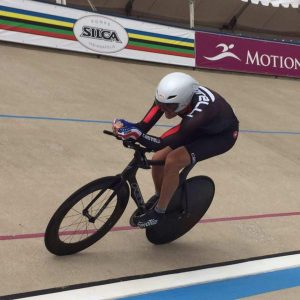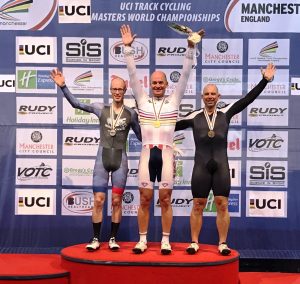The Relentless Pursuit of Cycling Aerodynamics – Part 2
I wrote an article for Lava Magazine earlier this year about a quest to find two more seconds in a 3 Km pursuit – a race that is over in just three and half minutes long. Now that the season is over, I can summarize the results of my efforts to gain these two seconds. It was a year where some gains were found, other hopes didn’t translate to much, and I came away seeing more testing opportunities for the future.
 My key race for the first part of this season was the 4 Km pursuit at Elite Track Nationals in July and then the second half of the season was geared toward a repeat trip to Masters Track Worlds in Manchester, England. I’d won the masters 3 Km title in 2015, but I came up 2.1 seconds shy of a UCI 40-44 world record time. I wanted those two seconds. While I’m always seeking faster positions and equipment, I found myself extra motivated to pursue the record in 2016. Considering Masters Track Worlds were on the same indoor velodrome this year as last, the potential ways to get two seconds faster were actually quite straightforward – find another 15 watts of average power, reduce my aerodynamic drag coefficient from 0.227 to 0.220, or some combination of both. How hard could that be? Famous last words.
My key race for the first part of this season was the 4 Km pursuit at Elite Track Nationals in July and then the second half of the season was geared toward a repeat trip to Masters Track Worlds in Manchester, England. I’d won the masters 3 Km title in 2015, but I came up 2.1 seconds shy of a UCI 40-44 world record time. I wanted those two seconds. While I’m always seeking faster positions and equipment, I found myself extra motivated to pursue the record in 2016. Considering Masters Track Worlds were on the same indoor velodrome this year as last, the potential ways to get two seconds faster were actually quite straightforward – find another 15 watts of average power, reduce my aerodynamic drag coefficient from 0.227 to 0.220, or some combination of both. How hard could that be? Famous last words.
Throughout the 2016 season, I trained hard and tested many different position changes and equipment. Here is what I found and the associated results:
SRM Power Meter Aerodynamic Field Testing –
 For virtual wind tunnel field testing, I used a track SRM. The Stages track power meter I used last year worked well, but the left-only measurement included some unquantifiable error in my quest for the most accurate aerodynamic drag measurements possible. While this doesn’t matter at all for general training, when looking for two seconds it could. I’ve used track SRM units for years on other bikes and I like them. However, unfortunately, this change didn’t include any faster speed on its own, only more accurate power results.
For virtual wind tunnel field testing, I used a track SRM. The Stages track power meter I used last year worked well, but the left-only measurement included some unquantifiable error in my quest for the most accurate aerodynamic drag measurements possible. While this doesn’t matter at all for general training, when looking for two seconds it could. I’ve used track SRM units for years on other bikes and I like them. However, unfortunately, this change didn’t include any faster speed on its own, only more accurate power results.
Bell Javelin Shield/Visor Aerodynamics –
I spent two days in 2014 testing the visor on and off the Bell Javelin helmet. Use of a helmet visor tests faster for some riders and slower for others, yet it often depends on wind conditions, which complicates things. When I tested in 2014, I couldn’t detect a difference and I went without the visor for the upside of additional cooling effect and the ability to hear cars better during training without it. When I tested with the visor again in 2016, the visor clearly showed up as offering a small advantage. So, what changed since 2014 to offer the visor and advantage? I suspect my new head position (I hold my head higher than before), lower hand position (recent UCI regulations required me to lower my aerobar extension angle), and hand and shoulders tweaks all contribute to a condition that causes the visor to be faster. As an added functional bonus, it is nice to have the slightly shaded visor on for outdoor concrete velodromes, which tend to be very bright in the sun.
My CdA tested 0.002 lower with the visor installed in my new position. A 4 watts improvement at my roughly 34 mph speed in the 3 Km was a good chunk of the drag reduction I was looking for.
Hand Width Aerodynamics –
I spent several days testing hand width this year. Thankfully this was pretty easy considering last year’s 3T Aura aerobar uses extensions that pivot your hand width closer together or further apart with just a little pressure (no bolts to adjust), making it as easy as a hand squeeze to test multiple hand positions in succession. When I first started testing, I could clearly tell something different was happening as there was no feeling of wind between my hands and arms. Feel is not always faster though, thus why I test. In this case, the results across several days of testing with magnitudes confirmed that my CdA dropped every time I pushed my hands together. My CdA was 0.001 lower on average with my hands together – another 2 watts.
Shimano Pro Missile Evo Aerobar Aerodynamics –
I wrote about this new aerobar in my last Lava article. The Shimano bar is a pain to set up, but I finally got it dialed in to match a UCI legal position that matched my existing 3T aerobar set-up and I could start field testing from there.
Without your own velodrome, field testing on a track bike has some challenges. I had to swap a front brake with each aerobar change so that adds some noise to the results with potential brake lever/aerobar interaction that wouldn’t be there on the track. Each day of testing I saw either no benefit or a slight benefit to the Shimano aerobar. Considering I’d spent a year testing every position I could think of with the 3T bar and an independent aero test said it was faster than the 3T bar (at least on a bike without a rider), I finally committed to the Shimano bar. At a minimum it was the same as the 3T and I could at least test some new positions and options that I had exhausted on the 3T otherwise. I stamped the official savings at a 0.001 CdA reduction using the Shimano aerobar, or about 2 watts.
Ultra Low Resistance Bottom Bracket –
I used a ceramic bottom bracket that tested exceptionally well through Friction Facts this year. I didn’t have a way of testing the difference though, so I picked the fastest rated model I could knowing that at worst it may not make a difference.
Castelli Body Paint 3 Skinsuit Aerodynamics –
I joked about trying to squeeze into a size smaller Castelli Body Paint 3 skinsuit last year. Over the winter, my statement became less of a joke when I ordered a Large instead of my usual XL. It literally took me 20 minutes to get into the smaller size initially. Thankfully, that got easier with time. I wasn’t able to test the results with the smaller suit as it was too complicated to field test in a workable time frame, so this was another area I went with what “they” say is faster. While tighter skinsuits are not always faster (particularly with textured shark-skin like material designed to create a more active boundary layer), this particular skinsuit reportedly tests faster with the tightest size possible. Next year I’m ordering a Medium. I’m definitely just kidding this time…
Wheel Aerodynamics for Indoor Velodromes –
The Mavic Comete double disc has been the top choice of most team and individual pursuit riders in the last several Olympics held on indoor velodromes. However, despite plenty of research and asking, I never could nail down how much faster, if any, this set-up was than my prior Zipp 808-Super9 disc with 700×23 Conti Supersonic tires setup that I use outdoors. Without the ability to do aero testing at the Velodrome, I was left wondering.
I still use my Zipp wheel setup for all outdoor and concrete velodrome racing which make up most of the United States track racing, but for the indoor race in Manchester, I trusted the Olympic medal count and was on the Mavic Comete double disc with Vittoria Pista 700×19 tires.
“Thumbs Forward” Aerodynamic Position –
 At the tail end of my testing season, I decided to test a small technique change and actually found what appears to be my biggest gain of the season. I tested a baseline position of just riding in the aerobars with the bottom two fingers of each hand holding the ends of the extensions – the hand position that tested faster than a dozen or so other variations through many test sessions. I then tested pushing my thumbs forward over the tips of the extensions while riding. This “thumbs-forward” technique pushes my hands out farther and, more importantly, pulls my shoulders forward and tighter together – nearly snug up against the sides of my helmet.
At the tail end of my testing season, I decided to test a small technique change and actually found what appears to be my biggest gain of the season. I tested a baseline position of just riding in the aerobars with the bottom two fingers of each hand holding the ends of the extensions – the hand position that tested faster than a dozen or so other variations through many test sessions. I then tested pushing my thumbs forward over the tips of the extensions while riding. This “thumbs-forward” technique pushes my hands out farther and, more importantly, pulls my shoulders forward and tighter together – nearly snug up against the sides of my helmet.
The “thumbs-forward” technique dropped my CdA 0.005 on average across two separate days of testing. However, the tricky part is that I used to push my hands against the ski tip extensions on my old 3T aerobars for a similar effect. While this new “thumbs-forward” technique showed an even greater benefit than that, the net CdA reduction over last year was likely something smaller. My best calculation was this lowered my CdA 0.003 over last year’s racing position, which meant a huge 6 watts!
Aero Benefit Summary –
Not taking the items I couldn’t accurately test into account (Mavic wheels, smaller skinsuit, and ceramic bottom bracket) the sum of my field testing showed an average CdA reduction of 0.007 over last year. This put me in the ballpark of a record if I could at least maintain my power and the atmospheric conditions at the event were similar to the year before.
| CdA reduction | Watts Saved | |
| Bell Javelin Helmet Visor | 0.002 | 4 watts |
| Hands Together | 0.001 | 2 watts |
| New Aerobar | 0.001 | 2 watts |
| Thumbs Forward Position | 0.003 | 6 watts |
| Total Savings | 0.007 | 14 watts |
When it comes to my total bike/rider estimated CdA, a careful dissecting of power/speed at Manchester reveals a total CdA of 0.221 for me (assuming a common Crr value of 0.001 for the fastest tires on the smoothest wooden indoor tracks). While this value is low for a 6’3 200 lb former rower/triathlete with broad shoulders, it also comes at the end of what’s been 10+ years of testing different equipment and positions. This is also a CdA calculated in a fast 250-meter velodrome, a value that can be lower than outdoors due to the banked turns where your center-of-gravity doesn’t have to travel as far as your wheels, and a second rider on the other side of the track can ‘sometimes’ help you go faster. “Sometimes” is the key word though. Especially if a pass has to be made, the other rider can actually slow you down.
So How Did I Do?
 My best effort this year in Manchester gave me a time of 3:25.70 – 0.75 seconds shy of the world record. I’d wondered a lot about how I’d feel missing it by a fraction of a second after all that effort, but I was surprised how fine I was with it. I won a second rainbow jersey for the world title, and I had the peace of mind that I’d given it everything I had and simply wasn’t fast enough to do it that day. While I could have paced it a little better, I knew with several laps to go I was falling off but going as hard as I could; every pedal stroke just wasn’t enough, and that was that.
My best effort this year in Manchester gave me a time of 3:25.70 – 0.75 seconds shy of the world record. I’d wondered a lot about how I’d feel missing it by a fraction of a second after all that effort, but I was surprised how fine I was with it. I won a second rainbow jersey for the world title, and I had the peace of mind that I’d given it everything I had and simply wasn’t fast enough to do it that day. While I could have paced it a little better, I knew with several laps to go I was falling off but going as hard as I could; every pedal stroke just wasn’t enough, and that was that.
If anything, the result leaves me more motivated to continue the journey. It’s a nice feeling knowing I trained as well as I could, ran the fastest position I could, and raced as hard as I could.
Epilogue: How Weather Affects Indoor Cycling Performance –
If I maintained my power from the year before at the race and I thought I made at least 14 watts of CdA improvement, and I only needed 15, how come I wasn’t even closer to the record?The answer is, “Weather.”.I may have had that record had the event been one day earlier.
Atmospheric pressure can have a big impact on speed, even inside a climate controlled indoor velodrome. There was a low pressure system that hung over Manchester until the day before the race this year. At 2 p.m. on race day of my qualifying heat the pressure was 30.13mm – 24 hours earlier it had been 29.68. That’s a difference of 1.0 seconds over 3 Km. While I can control all equipment, training and pacing variables, I haven’t figured out how to control the weather.
On a reassuring note for my testing, the change in pressure between the 2015 and 2016 race in Manchester accounts exactly for the difference in my estimated CdA time savings and actual time. This helped to validate my testing methods and I was pleased to finish another season with my fastest UCI legal set-up to-date; a set-up that I’ll be able to continue to work on improving next year.
Of course I’ll work all season to get as much power as I can out of my body too. However, with yet another birthday under my belt, my hopes for power improvement have been replaced by hopes to simply repeat last year’s power. I also plan to make a return to my outdoor time trial bike after two full years without racing it. Hopefully a number of these gains I’ve found on the track bike can lead to gains on the TT bike. All of this means that next season will have a full testing schedule for me once again.
Thanks for reading and feel free to post a comment if you want more information.
Dean
Co-owner/Lead Bike Fitter, Fit Werx MA
